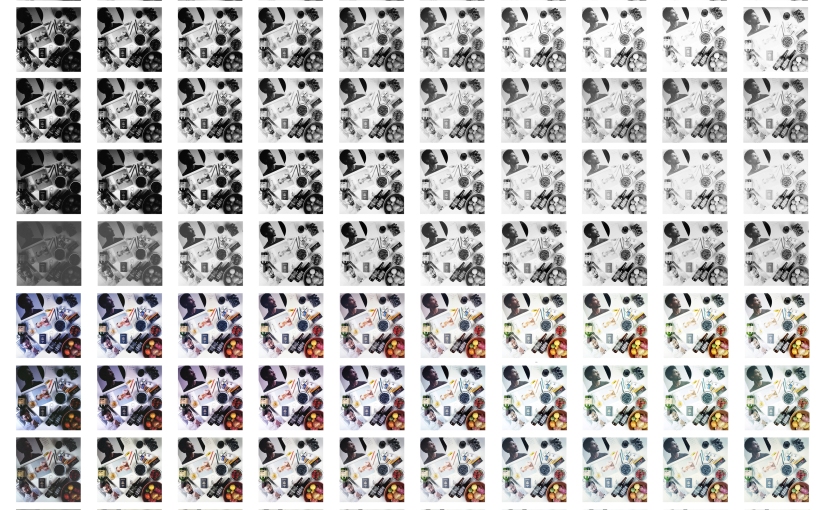In this experiment, we exposure tested 11 film stocks and Kodak Portra 400 pushed one stop to 800. Among the color films, we tested: Kodak Ektar 100, Kodak Portra 400, Portra 400 Pushed One Stop, Kodak Portra 800, and Fuji Pro 400H. Among the Black and White films, we tested: Ilford PanF, Kodak TMax 100, Kodak TMax 400, Kodak Tri-X, Ilford HP5, Ilford XP2 Super, Ilford Delta 3200.
To ensure consistency throughout the experiment, the film stock was the only experimental condition. The control conditions are as follows:
- Camera: Hasselblad 501CM
- Lens: 60mm f/3.5 CB
- Lighting: 2 Profoto B1X with diffusers
- Light meter: Sekonic Lightmaster
- Focusing Aid: Schneider Kreuznach 4x loupe
The loupe was used to set the focus at the start of the exposure test for each film stock. To ensure the exposure value (EV) was correct, the light meter (using an incident setting) was used to identify the neutral exposure as well as each EV in the center of the frame.
All B&W film was developed by the Darkroom Lab and all C-41 film was developed at home using a Jobo CPP2. All scans were done at home using an Epson V600. Each frame was scanned flat and adjusted in PS identically for all frames (‘true black’ was set by the darkest part of the record).
Results
The results did not turn out as I expected. Although, for most of films tested, I had no idea what to expect. While there are some sources out there doing some exposure testing, I have not found a source completely satisfactory. I approached Matt Seal about this idea and told him I wanted to do it. His interest, skillset, and appreciation for the scientific method made the compliment to my own intellectual pursuits and scientific rigor. It seemed like the perfect opportunity for us to learn about how exposure changes an image and how that change differs by film stock.
For those getting into film, with the exception of the famously linear response curve of Acros 100 (R.I.P.), most all film stocks have a logarithmic-type response curve. While every film stock is different, most all of them adhere to this pattern. As such, when you get to a certain point, it becomes more and more difficult to increase exposure by a full stop. In the film world, this is known as reciprocity failure. It generally only affects long exposures and depending on the film stock, can result in some color shifting after a certain point.
Getting back on track – it is because of this behavior in the response curve that allows you to continue to pour in the light without blowing out the highlights. It should be noted that the response curve is what makes film so unique and separates it from digital. Between film stocks, it is not just that colors are rendered different ways but it also interprets light differently. Comparing film with digital, digital has a perfectly linear response curve. This means that it blows out the highlights much faster but conversely, it does not lose details in the shadows near as quickly.
Results – Color Film
Comparing the neutral exposures, the Ektar is good bit more punchy while having a more delicate transition in tones. Portra 800 is noticeably warmer than even the Portra 400 – something I expected as it’s more contrasty but I didn’t expect it to quite the extent that it was.
I think I was most impressed with the Ektar of all the film stocks. I’ve only used it twice and neither time did I like the outcome. Although admittedly, both times I only had the scans from the local film lab in Charleston – and they had a really bad habit of over saturating any and all scans to the Nth degree. After those, I’ve stayed away from it from it until this testing. As soon as I saw these results, I picked up 2 pro packs to take on a trip to Banff.
Between the 2 400 speed films, I think that the Portra 400 held up a bit better than the Pro 400H when it comes to overexposing by more than 2 stops. But if you prefer cooler tones, you would probably conclude the opposite.
Results – Black and White Film
Perhaps unsurprisingly, most of the stocks behaved in a similar way except for the Delta 3200 – which didn’t get crushed blacks near as quickly or dramatically. This isn’t particularly unexpected given the difference in emulsion and the fact that it’s actually just a really flexible 1000 asa film.
Probably the most surprising performance was TMax 100. I think that it stood up to underexposure better than any of the other stocks and while I don’t see myself ever accidentally (or purposefully) overexposing by 5 stops, I think it handled the contrasty parts quite well. All in all, I’m going to have to pick some of this up an shoot it immediately.
As for second place in the biggest surprise, Ilford HP5 did a great job in my opinion. Since I tend to find myself in positions of not having enough light more than too much light, I care a lot about the ability to be underexposed. In this area, I think HP5 did really well.
Last specific thing I’ll touch on – I was genuinely surprised to see how similar T-Max 400 and Tri-X were. The Tri-X had a bit more grit but overall they were pretty similar.
Special Thanks
Of course, a huge thanks to Matt for the encouragement and supplying the all the equipment and his technical know-how to make sure the scientific rigor was above reproach. Could not have done it without him.
Thanks to Pete for his input, insight, and participation in the peer review(-ish) process. His input has been extraordinarily helpful in ensuring everything was reported in a clear and reproducible way.












